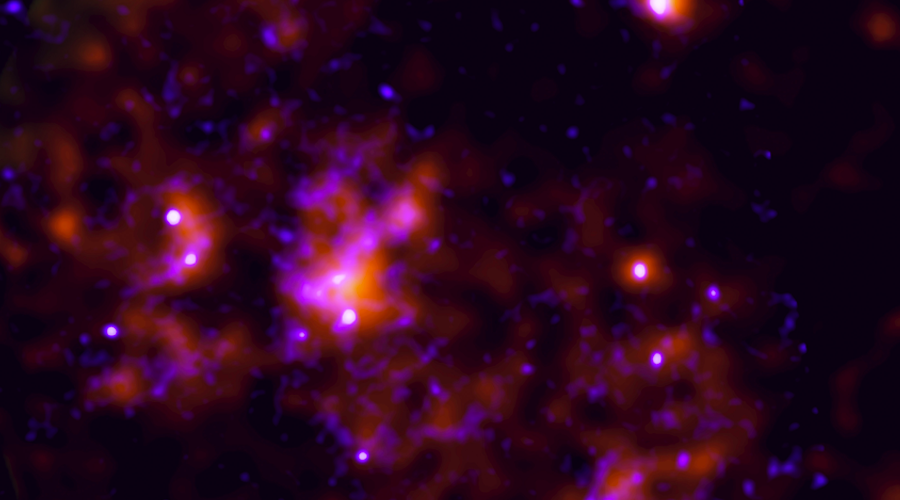 Sagittarius A*, the supermassive black hole at the center of the Milky Way, may have had a more turbulent, although short-lived, past, even if today it appears less bright and active than similar black holes. This is supported by the latest result obtained through the analysis of data provided by IXPE, a space telescope resulting from a collaboration between NASA, ASI Italian Space Agency, INFN and INAF National Institute for Astrophysics. In a paper published on Wednesday, June 21, in the journal Nature, the IXPE collaboration reports that the degree of polarization of light emitted by the giant gas clouds in the vicinity of Sagittarius A*, accurately measured by the space observatory's detectors, is consistent with an intense and temporary period of activity of the black hole, which resulted in an increase in its accretion rate and subsequent X-ray emission, and dating back some 200 years. Most 'molecular clouds,' this is the name given to the giant dust clusters located in the vicinity of galactic nuclei, are usually marked by low luminosity, denoting their being mostly cold and inert objects. However, recent studies have shown how molecular clouds at the center of our galaxy emit X-rays. A behavior that has prompted researchers to formulate possible explanations. In 2022, to better understand the phenomenon, IXPE, that measures the polarization of light in X-rays, i.e., the average direction and intensity of the electric field of light waves, turned twice, in February and March, toward these structures. By combining the data obtained with images from NASA's X-ray satellite Chandra, and comparing them with archival observations from ESA, the European Space Agency's XMM-Newton mission, it was possible to isolate the signal in the reflected X-rays and to discover its exact point of origin. IXPE is the first instrument capable of measuring the polarization of weak sources, such as molecular clouds in the Milky Way, and is also capable of measuring the shape and energy of extended X-ray sources, albeit with lower resolution than observatories optimized for these classical astronomical measurements. IXPE was able to confirm the morphological and spectral map of the region, enriching it with the information about the geometry of the system needed to explain the emission as the reflection of the past activity of the Galactic center reprocessed by molecular clouds. Therefore, the data collected by IXPE seem to confirm the hypothesis that the unusual glow is a reflection of a long-vanished X-ray flash of light emitted by Sagittarius A*, which would indicate a past transient awakening of the supermassive black hole at the center of the Milky Way, probably caused by the black hole's accretion following the absorption of some of the gas in those clouds. Further observations could confirm the result by reducing the uncertainty of the measurements and providing information on the size and distribution of the molecular clouds surrounding Sagittarius A*.
Sagittarius A*, the supermassive black hole at the center of the Milky Way, may have had a more turbulent, although short-lived, past, even if today it appears less bright and active than similar black holes. This is supported by the latest result obtained through the analysis of data provided by IXPE, a space telescope resulting from a collaboration between NASA, ASI Italian Space Agency, INFN and INAF National Institute for Astrophysics. In a paper published on Wednesday, June 21, in the journal Nature, the IXPE collaboration reports that the degree of polarization of light emitted by the giant gas clouds in the vicinity of Sagittarius A*, accurately measured by the space observatory's detectors, is consistent with an intense and temporary period of activity of the black hole, which resulted in an increase in its accretion rate and subsequent X-ray emission, and dating back some 200 years. Most 'molecular clouds,' this is the name given to the giant dust clusters located in the vicinity of galactic nuclei, are usually marked by low luminosity, denoting their being mostly cold and inert objects. However, recent studies have shown how molecular clouds at the center of our galaxy emit X-rays. A behavior that has prompted researchers to formulate possible explanations. In 2022, to better understand the phenomenon, IXPE, that measures the polarization of light in X-rays, i.e., the average direction and intensity of the electric field of light waves, turned twice, in February and March, toward these structures. By combining the data obtained with images from NASA's X-ray satellite Chandra, and comparing them with archival observations from ESA, the European Space Agency's XMM-Newton mission, it was possible to isolate the signal in the reflected X-rays and to discover its exact point of origin. IXPE is the first instrument capable of measuring the polarization of weak sources, such as molecular clouds in the Milky Way, and is also capable of measuring the shape and energy of extended X-ray sources, albeit with lower resolution than observatories optimized for these classical astronomical measurements. IXPE was able to confirm the morphological and spectral map of the region, enriching it with the information about the geometry of the system needed to explain the emission as the reflection of the past activity of the Galactic center reprocessed by molecular clouds. Therefore, the data collected by IXPE seem to confirm the hypothesis that the unusual glow is a reflection of a long-vanished X-ray flash of light emitted by Sagittarius A*, which would indicate a past transient awakening of the supermassive black hole at the center of the Milky Way, probably caused by the black hole's accretion following the absorption of some of the gas in those clouds. Further observations could confirm the result by reducing the uncertainty of the measurements and providing information on the size and distribution of the molecular clouds surrounding Sagittarius A*.




